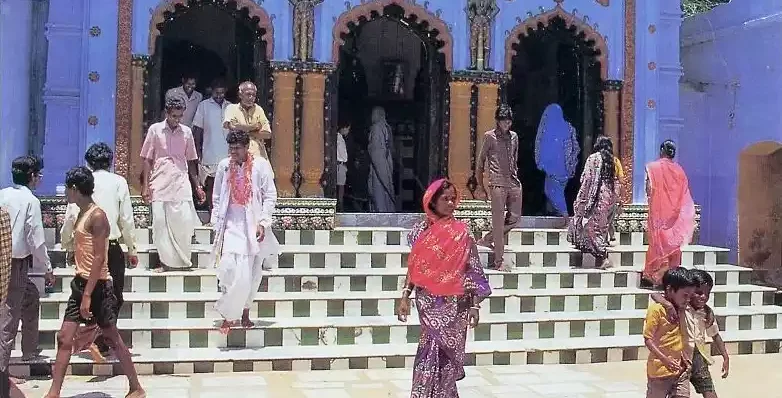REMUṆĀ—The Place of Pleasure
- January 31, 2023
- BTG Article
- 8 mins read
At this temple in Orissa, the Deity is famous as a thief.
Text by Bhakti Vikāśa Swami
Photos by Mahā-Viṣṇu Dāsa
(Article published in Back to Godhead Magazine in 1994)
REMUṆĀ IS A TINY VILLAGE in Orissa, but it’s quite a busy place, with people coming and going all the time. All the action centers on the temple of Kṣīra-corā Gopīnātha.
We have come to Remuṇā just at the end of the Candana-yātrā, when the Deities are smeared with cooling sandalwood pulp (candana). During the hottest time of the day, the priests apply candana to the chest of the temple’s three Kṛṣṇa Deities: Madana-mohana, Govinda, and Gopīnātha. On one day (Akśaya-tṛtiyā) Their whole bodies are smeared.

At Remuṇā, each day starts at 4:00 A.M. with chanting of the Hare Kṛṣṇa mantra, played from a cassette over loudspeakers in the temple compound. The cassette, produced by ISKCON Calcutta, is popular all over Bengal and Orissa.
Another pleasing feature of the temple is that the people in charge are genuinely pleased to welcome visitors. This reminds us of Remuṇā’s long tradition of welcoming devotees. We read in Caitanya-caritāmṛta of how well Mādhavendra Purī and Lord Caitanya were received here.
SEEING THE LORD’S FORM
The pūjārī (priest) told me, “You must come and see the dressing of the Deities at 6:30 in the morning.” So we went. To be allowed to see the dressing of a Deity is rare, but here everyone can come see. Gopīnātha appears carved from a piece of stone, like a bas-relief, except that most of His form is visible. On the stone are other figures, said to be carved by Lord Kṛṣṇa in His incarnation as Lord Rāmacandra. The pūjārī showed us these figures.

We also found out why Gopīnātha’s flute looks rectangular, as you can see in His photo, rather than cylindrical: the flute you see covers the original flute, which is rectangular and is part of the Deity.
As the dressing began, only Mahā-Viṣṇu Dāsa and I were there to watch. Gradually a few more people came, everyone looking intensely at the beauty of the Deities. We sat chanting on our beads, drinking through our eyes the beauty of Govinda, Gopīnātha, and Madana-mohana. (The Deities of Govinda and Madana-mohana were brought here from Vṛndāvana about 1938 by a devotee named Caitanya dāsa Bābājī.)
The pūjārī quickly and expertly dressed the Deities using simple cloth, which he twisted and turned to make an attractive outfit.
REMUṆĀ’S HOLY SITES
I first came to Remuṇā in 1978. The place now is more developed. Nothing grand, but there are a few shops, and many more people come to see the Deity. Many come to arrange for sons and daughters to be married in the temple.
Pilgrims come in a steady flow throughout the day, but no big crowds like the ones you’ll find at Purī, Tirupati, or Nāthadvāra. Probably a few hundred pilgrims a day visit here, a thousand or so on Sundays. We are here in the summer, when there are not so many visitors. In the winter, when the weather is cool, more people come, mostly from Orissa and Bengal. Many people who visit belong to various Gauḍīya Vaiṣṇava sects, groups of followers of Lord Caitanya. Several Gauḍīya families have settled here.
Previously Remuṇā was directly on the route between Bengal and Purī. Now it’s slightly off the route. The main rail line goes through Baleshwar, twelve kilometers east. The original route still exists and is known as Gaura-danda, “the path touched by the holy feet of Lord Caitanya.”

The Gopīnātha temple stands in an area by itself in the fields, about half a kilometer from the village of Remuṇā. At the main entrance to the temple, a bakula tree with huge branches marks a spot said to be the site of the first temple, built by King Narasiṁhadeva.
About two hundred meters from the present temple, near the temples of Rāmacaṇḍī and Gargasvara, there used to be a village market. The local people say it belonged to a cowherd village where every day the villagers gave sixty liters of milk to make Gopīnātha a spiced condensed milk called amṛta-keli. The market, it is said, is where Mādhavendra Purī stayed when he came to Remuṇā. Mādhavendra Purī’s sitting place and wooden shoes are worshiped at a small temple at the spot. The temple is the samādhī (tomb) of Mādhavendra Purī.
In two places at the Gopīnātha temple, pilgrims worship the footprints of Caitanya Mahāprabhu. The footprints are modeled after the ones in the Jagannātha temple in Purī, where Caitanya Mahāprabhu would stand next to the Garuḍa-stambha, the pillar holding Garuḍa, the eagle carrier of Lord Viṣṇu. It is said that Lord Caitanya felt such intense ecstasy upon seeing the Jagannātha Deity that His feet melted impressions into the stone floor.
A little shop at the Gopīnātha temple sells books in Oriya, Bengali, and English telling about the glories of the temple. The shop sells photos of Gopīnātha (for visitors to photograph the Deity is prohibited). The shop also sells sweets to offer the Deity. After being offered, the sweets are given back to the person who bought them, a common system in India.

Just outside the entrance to the temple is a small manmade pond. It has steps going down to it so one can reach it to bathe. Another pond, a very old one, about a hundred meters from the temple, is where devotees from Bengal would bathe on the way to see Lord Caitanya in Purī. Caitanya Mahāprabhu, Nityānanda Prabhu, Mādhavendra Purī—so many great souls must have bathed here. And now we are so fortunate to get that chance. Although the pond has become the local place where people come to wash their clothes, the spiritual benefit of bathing there remains.
About a ten-minute walk from the temple of Kṣīra-corā Gopīnātha is a branch of the Gauḍīya Maṭha, the mission of Śrīla Bhaktisiddhānta Sarasvatī Ṭhākura, Prabhupāda’s spiritual master. When he came here just a few years before he left this world, he wanted to start a branch of his mission here but did not accomplish that desire. Shortly after he left this world, however, someone donated for the Gauḍīya Maṭha in Remuṇā a 300-year-old Jagannātha temple. Besides the Jagannātha Deities, the temple is now the home of Rādhā-Kṛṣṇa Deities originally installed by Śrīla Bhaktisiddhānta Sarasvatī in Mymensingh, in what is now Bangladesh. The Rādhā-Kṛṣṇa Deities were brought here when Bengal was partitioned.
The Remuṇā area is also the birthplace of Śrīdhara Svāmī, the original commentator on Śrīmad-Bhāgavatam, and Baladeva Vidyābhūṣaṇa, a great spiritual master in the line of Lord Caitanya. You can visit their birthplaces if you can find someone to guide you; most of the local people don’t seem to know about these places.
Tasting the Nectar
Last night I was able to fulfill a long-held desire to read the story of Kṣīra-corā Gopīnātha in front of the Deity Himself. By good fortune, someone here had a copy of the Caitanya-caritāmṛta, and I was able to read that in front of the Deity. Eight devotees arrived from Māyāpur today on their way to Purī, and they have asked me to read the story to them tonight.

Remuṇā is famous for the condensed milk called amṛta-keli, which is very sweet. And we enjoy another kind of sweet nectar here—the Caitanya-caritāmṛta. Both of these sweet nectars are enjoyable at Remuṇā—the place of transcendental pleasure.
TUMULTUOUS WORSHIP
Evening ārati (worship) at the Kṣīra-corā Gopīnātha temple is spectacular. Just before 7:00 P.M. the curtain draws closed. Two pūjārīs in the Deity room bang gongs, someone in the courtyard bangs a big drum, and a kīrtana group sings and plays mṛdaṅga drums and karatālas (hand cymbals), all together making a tremendous sound.
At seven the curtain is whisked open. Everyone outside the Deity room offers obeisances, and the kīrtana picks up again with full volume. The pūjārī offers incense and camphor while a second pūjārī stands behind him waving a cāmara (yak-tail whisk). Although the temple always has electricity, during the ārati a man holds a traditional torch of oil-soaked cloth.
After the pūjārī has offered the incense, the curtain is closed while he lights the ghee lamp. Meanwhile the kīrtana goes on, and when the door opens, the kīrtana becomes intense—bang! bang! bang!
The pūjārī offers the ghee lamp and then water in a conch shell. When he finishes, he walks through the kīrtana courtyard, throwing the water on both sides, as all the devotees offer obeisances to get the water on their heads. The ārati lasts about ten minutes.
VISITING REMUṆĀ
The best way to get to Remuṇā from Calcutta is to take a train from Howrah station to Baleshwar, about a five-hour trip, depending on the train. From Baleshwar you can go the twelve kilometers to Remuṇā by taxi, auto riksha, or bus.
There’s a small guesthouse at the Gopīnātha temple, and there are some good hotels in Baleshwar.
You can get prasāda at the Gopīnātha temple at midday and in the evening. You reserve your meal by paying in advance. You’ll get a plate of rice, dāl, chutney, and two vegetable dishes.
The temple’s famous spiced condensed milk is available in the afternoon and evening, in small, medium, and large pots.



